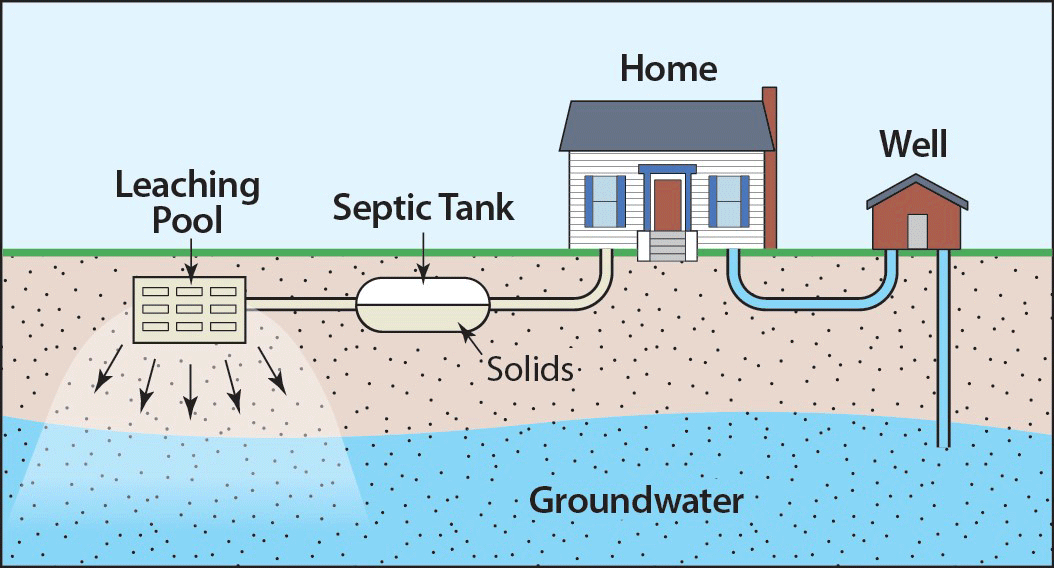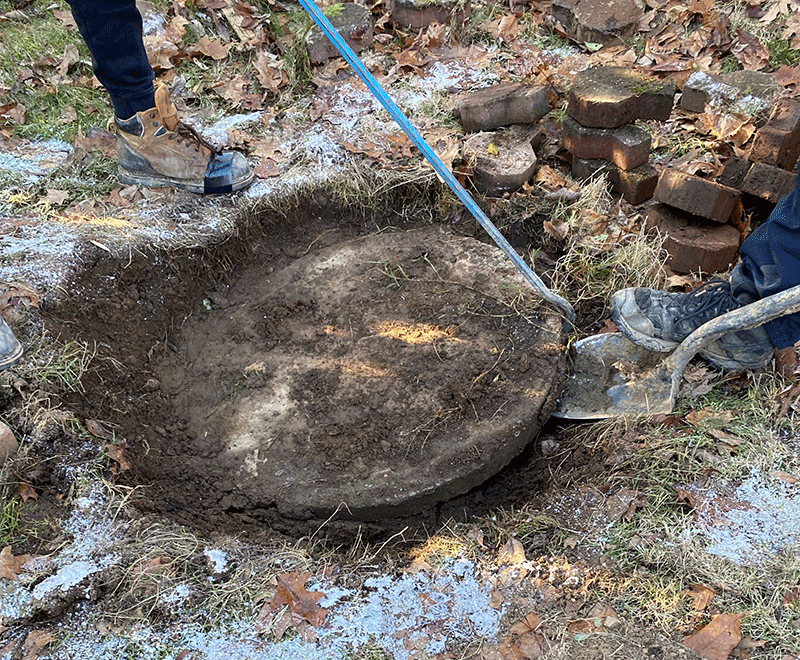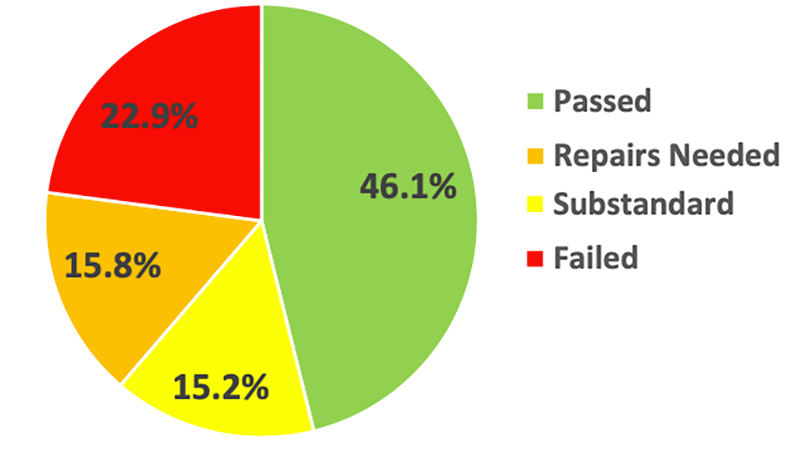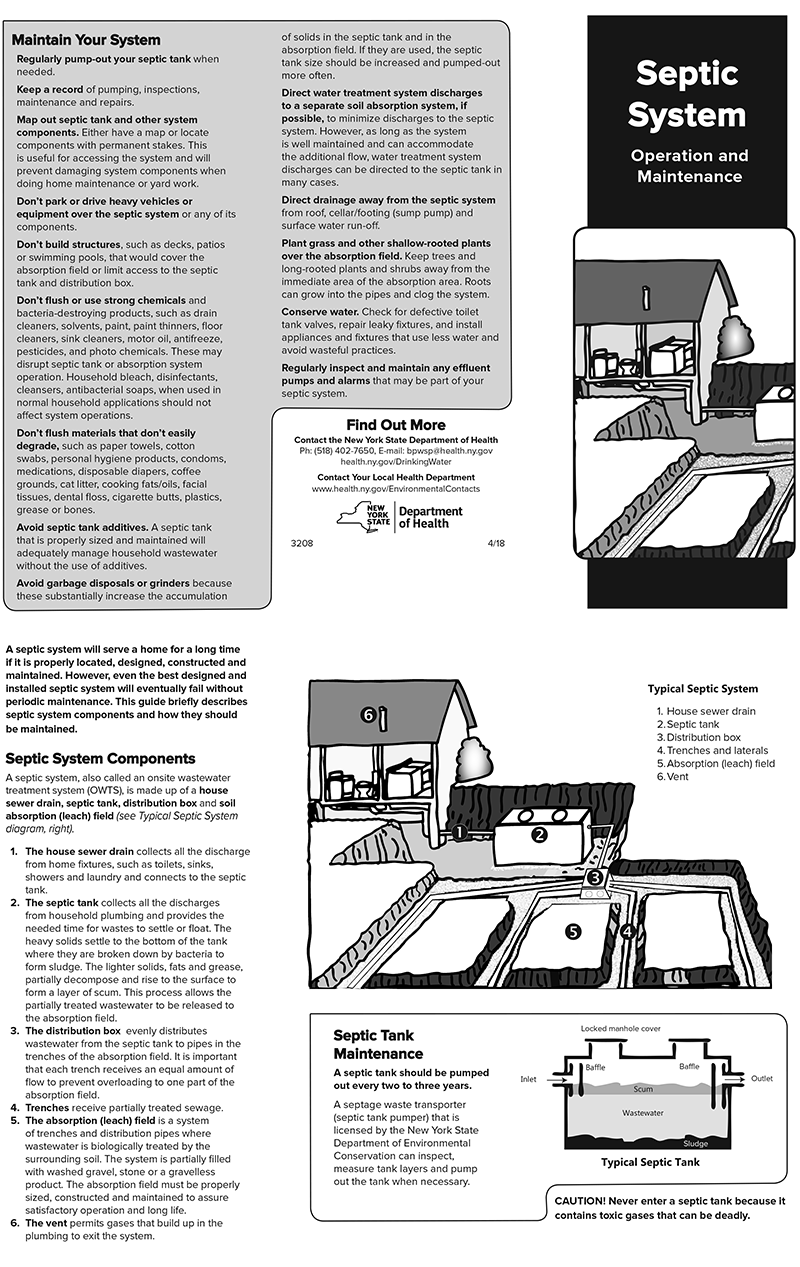Across New York and in the Adirondack Park, failing and improperly sited, designed, or installed onsite wastewater treatments systems (OWTSs), commonly referred to as septic systems, are a leading cause of water pollution that harms the environment and public health. New York needs major reforms of its septic system regulations, which lag behind most of rest of the states across the U.S. New York needs reforms that requires, at a minimum, mandatory septic system inspections at the time of property transfer.
New York’s Regulatory Framework is Outdated and Underperforming
New York has outdated septic system control regulations that are some of the weakest in the country. In New York, regulation of a septic system occurs when a system is constructed, according to local regulations or the Department of Health, depending on the size of the development, but there is no statewide framework for assessing the viability of old systems that have been in use for years.
Septic systems are not designed to last forever and should be replaced or upgraded periodically. Septic systems should also be replaced or enhanced when improvements are made to a residence (e.g., more bedrooms or bathrooms are added) that increase the need for greater capacity in the system. There is no statewide law in New York that requires property owners to inspect, maintain, or upgrade existing septic systems. There are some local controls, such as in the Lake George basin governed by the Lake George Park Commission, or through various local or county regulations. This is the case in numerous places in the Adirondack Park where many seasonal camps and year-round dwellings have been renovated and expanded, but the OWTS has remained the same. In some instances of older homes, the OWTS is nonexistent.
When well-designed to the conditions of a given site, properly installed, and regularly maintained, an OWTS can work very well and can function effectively for 25 years or more. Many systems were not well-designed and are not regularly maintained.
Septic System Effluent Causes Public Health and Environmental Impacts
The effluent from failing septic systems can result in harmful public health and environmental impacts. Wastewater can contain harmful bacteria, particularly fecal coliforms, viruses, and protozoa that can reach waters near the OWTS. These contaminants in the water can result in adverse public health impacts ranging from “minor ailments, such as ear or eye infections [to] major diseases, such as dysentery or hepatitis.” Some strains of E-coli bacteria, which are a fecal coliform that can be present due to fecal pollution in the water, can cause serious illness. Also, wastewater containing “[h]ousehold chemicals can be poisonous to humans, pets, and wildlife if they are not treated.”
Failing or poorly sited septic systems can negatively impact the environment by contributing excess phosphorus, nitrates and chloride to nearby waterbodies. Excess phosphorus can lead to increased growth of algae and aquatic plants, that in turn reduces oxygen in the water, which can harm fish and lead to other negative impacts to water quality. One of the impacts of increased algae growth is the potential for harmful algal blooms (HABs) to be produced in the water.
New York has seen a rise in HABs in the past decade. HABs are driven by the loading of nutrients and other pollutants that overwhelm an aquatic system. One key contributor to increasing HABs is contamination from septic systems. A study of a freshwater estuary in Florida found that “wastewater contamination”, not stormwater runoff or other groundwater flows, “from septic systems was a major contributor to the high nitrogen concentrations” that support the growth of HABs.
Excess nitrates can be found in drinking water as a result of septic systems that are failing. Nitrates in drinking water can cause serious illness in humans, particularly infants and those with gastrointestinal disorders, because it reduces the blood’s ability to carry oxygen. High concentrations of chloride in the water can “impact freshwater organisms and plants by altering reproduction rates, increasing species mortality, and changing the characteristics of the entire local ecosystem.”
Prevalence of Failing Septic Systems
A 2001 Cornell University report found that 20% of septic systems across New York State are failing. Closer to home, and here in the Adirondacks, fresh data from the Lake George Park Commission’s newly enacted septic inspection program reveals that 84% of septic systems in the Lake George basin have “challenging site characteristics” for siting an adequate septic system. As shown in the pie chart below, in this first round of inspections performed in 2023 by the Lake George Park Commission, 23% of tested systems failed, 16% were substandard, 15% needed minor repairs, and 46% passed. In the Town of Queensbury, of the 148 inspections conducted in 2023, 47 of them (or 32%) resulted in a failed inspection.
Legislative Solutions: Educating Homeowners on Maintenance of Septic Systems, Septic Inspection at Transfer Law, and More Funding for Septic Replacements
New York State needs new regulations that will require property owners to maintain functioning, adequately-sized septic systems. Short of regulatory reform requiring maintenance, property owners can be reminded about the importance of maintaining functioning septic systems. A new bill (S.8506/A.9330) introduced by Senator Pete Hackham and Assemblymember Chris Burdick, cosponsored by Assemblymember Carrie Woerner, would require sellers of property served by a septic system to provide the buyer with a copy of the New York State Department of Health pamphlet about septic system maintenance. Protect the Adirondacks supports passage of this bill as an initial, commonsense approach to educating homeowners about the need to maintain their septic systems.
Protect the Adirondacks also supports legislation that would require an inspection of the septic system at the time that property is transferred from one owner to another. This type of inspection is often conducted during a property transaction, but not always and it is not mandatory. Such a bill would require failing systems to be fixed prior to the property transfer. Property transfers are usually the time when funds are available, or “on the table”, to pay for the necessary repairs and/or replacement of the septic system for the property. Other states already require these inspections at the time of transfer of title. For example, Massachusetts has had this requirement in place since 1995. In the Adirondacks, the Towns of Queensbury, Inlet and Bolton, among others, have such laws.
In order to help property owners initiate septic system replacements outside of property transfers, the State offers some funding for homeowners that have properties in participating counties. The State also has specific criteria that prioritize which counties are given funding to distribute to homeowners. The criteria include the presence of a sole-source aquifer used for drinking water, a water quality impairment linked to failing septic systems, and/or the ability of septic system replacements to mitigate water quality impairments. The funding for this program is from the Clean Water Infrastructure Act.
Top picture courtesy Center for Clean Water Technology at Stony Brook University.









